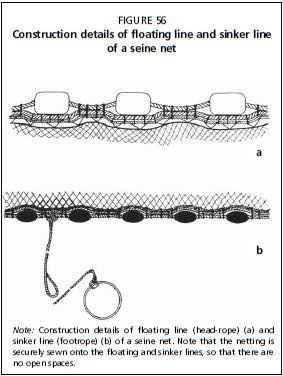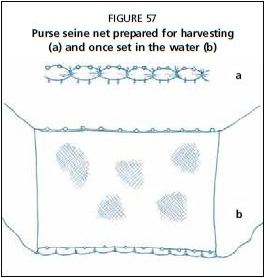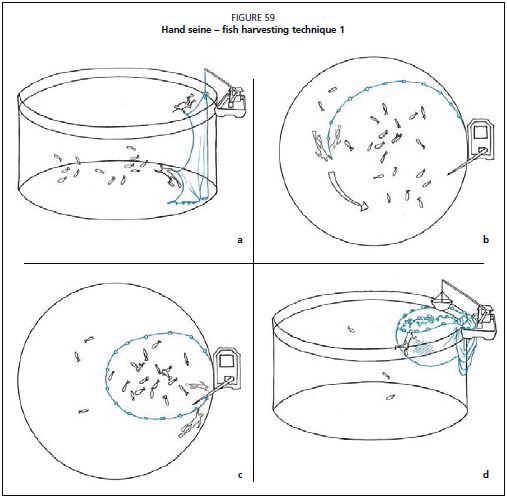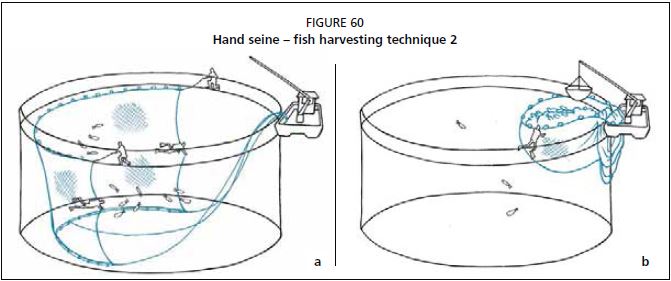HARVESTING METHODS
Purse seine
The purse seine technique is appropriate for harvesting large quantities of fish or when the cage needs to be completely harvested. It uses a large fishing net, whose length is at least as long as the cage's perimeter, to encircle all the fish present inside the cage.
A standard purse seine net is rectangular in shape, made with light netting (e.g. nylon 210/24) to simplify handling, with a mesh size proportionate to the size of the fish.

The seine net has floats on the upper line (head-rope) (Figure 56a), while the lower line (footrope) has a lead line sewn in (Figure 56b) to ensure correct orientation in the water column. The seine net's dimensions should be: Height = cage wall height + one-sixth of cage diameter
Length = cage circumference
Floating and sink er dimensioning will depend on cage dimension and biomass to be harvested the larger the cage and the biomass to be harvested, the greater the buoyancy and sinking of the fishing net will be necessary.
Along the length of the footrope, pursing rings are attached, through which runs a purse line, which extends up to the workers on the surface. When this purse line is pulled taut, the lower part of the net will close ("pur se") and the entire fishing net will became a closed bag with a sealed bottom.
In preparation for the harvest, the seine net is gathered up so that the head-rope lies close,

and parallel, to the footrope. The head-rope is then secured with short “bundling” lines tied with “quick-release” knots (Figure 57).
The net is bunched in this way so that it can be set inside the cage, around the perimeter, until the two opposite ends of the net are close to each other; usually, the ends should meet near where the boat is moored (Figure 58a). When ready, the “bundling” lines are quickly released so that the net lead-line drops quickly to the bottom (Figure 58b).
Divers check to ensure that the net is properly set and that it is not tangled or twisted. The two vertical opposite ends of the net are then joined together with plastic cable ties (“zip” ties).
The next phase consists of closing the seine net lead-line by pulling on the pursing line so that a closed “purse” is obtained, separate from the farm net (Figure 58c).The divers’ task at this time is to ensure that the lead-line does not lift off the cage net floor until the final closing of the purse, so that the fish cannot escape from the bottom.
Once the fish are “pursed” and before hauling the net, it is important that the divers perform a visual estimate of the number of fish in order to avoid excessive harvesting.
Excess quantities of fish can be released by the divers back into the net cage through the bottom before the purse is completely closed.

Once the purse has been completely closed, the net is hauled in by workers with the aid of the crane, if needed (Figure 58d).
As the net is hauled in, and the seam is out of the water, the plastic cable ties which hold the two vertical ends together are cut, and the net is opened and laid along the handrail. Care must be taken to avoid trapping and damaging fish in any of the netting folds. As the net is hauled in, the volume inside the seine net decreases, until the fish start to appear on the surface. At this time, it is still possible to release excess fish by simply submerging the float line.
Once the required quantity of fish has been secured, and the net is fastened on the handrail, fish are harvested with a special scoop net (also known as a "brailing net" or "landing net") (Plate 121). This scoop net is manoeuvred using the boat's crane, and

its base can be opened by triggering a quick-release system that allows the fish to be released into the bins without inverting the scoop net. The frame of the scoop net is made of steel. The base of the scoop is closed by a wire passing through several rings. The wire is fixed onto the top of the scoop bridles (red arrow in Plate 121b), and thence onto an automatic locking system (i.e. a quick-release snap hook). When the wire is released, the scoop net base is opened to release the fish.
Hand seine net
Technique 1
This harvesting technique is similar to that used in the purse seine method just described, but the seine width is smaller (from one-third to one-half of the cage circumference). The smaller net is easier to handle, and it is used in a different way. This system requires fewer workers, and is suitable for use when a limited number of fish are to be harvested or when a cage is densely populated.
The seine net is set vertically inside the cage from the boat, which is moored onto the cage collar (Figure 59a).
The divers fix one end of the net to the cage wall, using plastic cable ties ("zip" ties). The free end of the seine is pulled by divers along the cage's perimeter (Figure 59b) until the circle is closed with the opposite side of the seine (Figure 59c).

The two sides of the seine may then be secured with some plastic cable ties, while the ties previously fixed to the wall are cut free, releasing the seine net.
From this position, operations proceed as described above for the purse seine (Figure 59d).
Technique 2
The seine net is lowered into the water on the opposite side of cage from the boat (Figure 60).
The seine net is slowly pulled towards the boat by the operators on the cage and by the divers who drive the seine close to the walls of the cage. Divers also ensure that the lead-line moves forwards together with the rest of the net (Figure 60a). The divers are responsible for estimating the number of fish in the net and for allowing some to escape the harvesting seine, as appropriate.

The lead-line can be handled from the boat, through ropes connected to the net bottom. The hauling in is completed by the lines handled by the crew on the boat.
The lead-line is lifted, and the purse is closed (Figure 60b). Once the purse is closed, the rest of the harvesting proceeds as described above.
Lift net system
The lift-net harvesting system is simple and effective, and the fishing net used is cheap and of simple construction. The lift net has no floats or sinkers. It is a circular shaped net with a diameter of at least 1.5 times the diameter of the cage. It is reinforced with two perpendicularly crossed ropes and fitted with a series of hooks ("snap hooks" or "carabineers" are best) along its perimeter.
The first part of the operation consists of laying the lift net completely over the base of the cage (Figure 61a).
One or two divers gradually lift the net to the surface (Figure 61b).
This operation is done gradually, as divers swim from the bottom upwards, following a spiral path (Figure 61c). The hooks are detached and then re-positioned onto the cage wall, progressively higher and higher, so that after a number of rounds, the lift net is close to the surface (Figure 61d).
Once the lift net is completely at the surface, it is hauled by the surface crew so that the lift net is close to the harvest boat. Harvest then proceeds as for the other harvest systems described above.
Small internal harvest cage
This system is a strategy to facilitate later harvesting without affecting the rest of
the fish in the cage by containing a subset of the fish in an internal cage. A smaller, rectangular cage is installed inside the larger farm cage (Plate 122 and Figure 62).

The advantages of this method are twofold:
The fish fasting will be confined to the batch inside the small "harvest cage", while the other fish will be fed regularly.
The reduced volume of the smaller cage will facilitate harvesting operations, which will therefore be quicker and will require the use of fewer personnel and less equipment.
For example, a cage of 19 m diameter, 60 m circumference and 10 m wall height can be equipped with a smaller cage of about 10 ? 4 ? 10 m height.
The lateral side of the internal harvest cage has a door that can be closed by a zipper. The zipper runs along three edges of the harvest cage so that the whole side can be completely opened (Figure 62a). The method consists of herding the desired quantity of fish into this smaller cage. This quantity should be sufficient for several further harvests to be performed over the following few days.
To fill the harvest cage, the hand seine can be used (Technique 1) as described above. The difference is that the ends of the seine, top and bottom, are attached onto the open side of the harvest cage. The hand seine is manoeuvred so that the end of the harvest cage is open

(Figure 62b). The seine wall made by the divers will then push the fish inside the harvest cage. The open wall of the harvest cage can then be closed, concluding the operation (Figure 62c).
Harvesting from the small harvest cage can be performed using either of two methods:
A rectangular hand seine, similar to that. shown above, but of much smaller size. The entire harvest cage can be hauled up, if the biomass has been sufficiently reduced by previous harvests.
Whichever technique is applied, when the net is hauled in, a "bag" will be created, with the fish inside ready for harvesting.
Harvest systems can vary widely. Every farm and every harvesting team has its own techniques, based on its experience, the equipment and the facilities available at that site.
For all the above techniques, the divers who handle the seine nets play a critical role. The divers must:
• Understand the movement of the fish inside the cage, and adjust the net accordingly. • Understand how many fish are enclosed in the harvesting net, and give a signal to the surface operators when the net has to be hauled in.
• During the hauling phase, they have to estimate the fish biomass that is in the harvest net, and determine how many of the excess fish should be set free back into the cage net.
These skills are particularly important to minimize the harvest risks described at the beginning of this section.